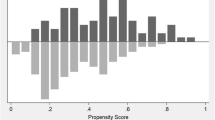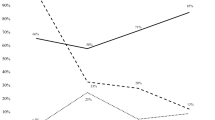Abstract
A theoretical model is described which conceptualizes school crime and disruption as a function of the congruence or fit between the personal characteristics of students and the social environments of the schools they attend. In a direct empirical test of the model, indices representing 10 distinct dimensions of student-school fit are related to three composite measures of school misconduct: school crime, school avoidance, and class misbehavior. A number of significant relationships are found between dimensions of student-school fit and the three indices of school misbehavior, several of which manifest one of the nonlinear forms specified by the model, providing at least modest support for a person-environment fit theory of school crime and disruption.
Similar content being viewed by others
References
Bailey, S. K. (1970).Disruption in Urban Public Secondary Schools, National Association of Secondary School Principals, Washington, D.C.
Blalock, H. M., Jr. (1960).Social Statistics, McGraw-Hill, New York.
Caplan, R. D., Cobb, S., French, J. R. P., Jr., Harrison, R. V., and Pinneau, S. R., Jr. (1975).Job Demands and Worker Health: main Effects and Occupational Differences (USGPO Catalog No. HE 20.7111:J57. USGPO Stock No. 1733-00083), U.S. Government Printing Office, Washington, D.C.
Cardinell, C. F. (1969). Relationship of interaction of selected personality characteristics of school principal and custodian with sociological variables to school vandalism. Unpublished doctoral dissertation, Michigan State University.
Coleman, J. S. (1961).The Adolescent Society, The Free Press, Glencoe, Ill.
Elliott, D. S., and Voss, H. L. (1974).Delinquency and Dropout, D. C. Heath, Lexington, Mass.
Erickson, M. L., Scott, M. L., and Empey, L. T. (1964).School Experience and Delinquency, Brigham Young University, Provo, Utah.
French, J. R. P., Jr. (1973). Person role fit.Occup. Ment. Hlth 3: 15–20.
French, J. R. P., Jr. Rodgers, W., and Cobb, S. (1974). Adjustment as person-environment fit. In Coelho, G. V., Hamburg, D. A., and Adams, J. E. (eds.),Coping and Adaptation, Basic Books, New York.
Glaser, D. (1975).Strategic Criminal Justice Planning, U.S. Government Printing Office, Washington, D.C.
Gold, M. (1978). Scholastic experiences, self-esteem, and delinquent behavior: A theory for alternative schools.Crime Delinq. 24: 290–308.
Goldman, N. (1961). A socio-psychological study of school vandalism.Crime Delinq. 7: 221–230.
Greenberg, B. (1975).Program for the Prevention and Control of School Vandalism and Related Burglaries, Stanford Research Institute, Menlo Park, Calif.
Harrison, R. V. (1978). Person-environment fit and job stress. In Cooper, C. L., and Payne, R. (eds.),Stress at Work, Wiley, New York.
Hirschi, T. (1977). Causes and prevention of juvenile delinquency.Sociol. Inquiry 47: 322–341.
Jorgenson, G. W. (1977). Relationship of classroom behavior to the accuracy of the match between material difficulty and student ability.J. Educ. Psychol. 69: 24–32.
Kahle, L. R., Kulka, R. A., and Klingel, D. M. (in press). Low adolescent self-esteem leads to multiple interpersonal problems: A test of social adaptation theory.J. Personal. Soc. Psychol. in press.
Kelly, J. G. (1979).Adolescent Boys in High School: A Psychological Study of Coping and Adaptation, Lawrence Erlbaum, Somerset, N.J.
Kulka, R. A. (1975). Person-environment fit in the high school: A validation study (2 vols.). Doctoral dissertation, University of Michigan (University Microfilms No. 76-9438).
Kulka, R. A. (1979). Interaction as person-environment fit. In Kahle, L. R. (ed.),New Directions for Methodology of Behavioral Science: Methods for Studying Person-Situation Interactions (No. 2), Jossey-Bass, San Francisco.
Kulka, R. A., Klingel, D. M., and Kahle, L. R. (1979). Antecedents and consequences of alienation and involvement in high school. Paper presented at the meeting of the American Psychological Association, New York, September.
Kulka, R. A., Mann, D. W., and Klingel, D. M. (in press). A person-environment fit model of school crime and disruption. In Rubel, R. J., and Baker, K. (eds.),Theoretical Perspectives on Crime and Violence in the Public Schools, Lexington Books, Lexington, Mass.
Lewin, K. (1951).Field Theory in Social Sciences (Cartwright, D., ed.), Harper & Row, New York.
Locksley, A., and Douvan, E. (1979). Problem behavior in adolescents. In Gomberg, E. S., and Franks, V. (eds.),Gender and Disordered Behavior: Sex Differences in Psychopathology, Brunner/Mazel, New York.
McPartland, J. M., and McDill, E. L. (1977). Research on crime in schools. In McPartland, J. M., and McDill, E. L. (eds.),Violence in Schools: Perspectives, Programs, and Positions, D. C. Health, Lexington, Mass.
National Institute of Education, U.S. Department of Health, Education and Welfare (1977).Violent Schools — Safe Schools: The Safe School Study Report to the Congress, Vol. 1, U.S. Government Printing Office, Washington, D.C.
Newman, B. M. (1975). Characteristics of interpersonal behavior among adolescent boys.J. Youth Adoles. 4: 145–153.
Polk, K., and Schafer, W. E. (eds.) (1972).Schools and Delinquency, Prentice-Hall, Englewood Cliffs, N.J.
Strauss, G. H. (1974). Two perspectives on high school student politics: Political objects versus political actors.Youth Soc. 5: 360–376.
U.S. Senate Subcommittee to Investigate Juvenile Delinquency, Committee on the Judiciary (1977).Challenge for the Third Century: Education in a Safe Environment — Final Report on the Nature and Prevention of School Violence and Vandalism, U.S. Government Printing Office, Washington, D.C.
Wenk, E. A. (1974). Schools and delinquency prevention.Crime Delinq. Lit. 6: 236–258.
West, W. G. (1975). Adolescent deviance and the school.Interchange 6: 49–55.
Wilson, J. Q. (1977). Crime in society and schools. In McPartland, J. M., and McDill, E. L. (eds.),Violence in Schools: Perspectives, Programs, and Positions, D. C. Heath, Lexington, Mass.
Yinger, J. M. (1965).Toward a Field Theory of Behavior, McGraw-Hill, New York.
Author information
Authors and Affiliations
Additional information
An earlier version of this paper was presented at the annual meeting of the Society for the Study of Social Problems, San Francisco, September 1978. Analyses reported here were supported by a research grant (G-78-0049) from the National Institute of Education.
Received Ph.D. in social psychology from the University of Michigan. Current research interests include alienation and involvement in high school, person-environment fit, and survey methodology.
Current research interests include the development and treatment of aggressive and deviant behavior in adolescence and socialization experiences in high school.
Received Ph.D. in personality psychology from the University of Michigan. Current research interests include adolescent self-esteem, delinquent behavior, and alternative schools.
Rights and permissions
About this article
Cite this article
Kulka, R.A., Klingel, D.M. & Mann, D.W. School crime and disruption as a function of student-school fit: An empirical assessment. J Youth Adolescence 9, 353–370 (1980). https://doi.org/10.1007/BF02087987
Received:
Issue Date:
DOI: https://doi.org/10.1007/BF02087987




